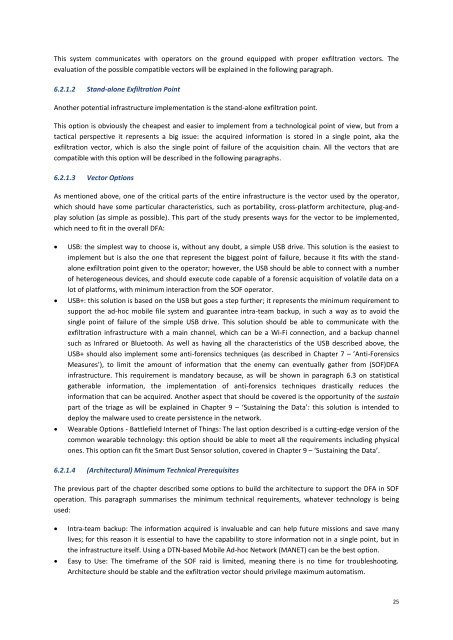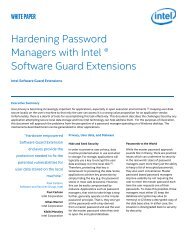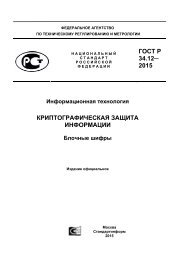BATTLEFIELD DIGITAL FORENSICS
BDF_Battlefield_Digital_Forensics_final
BDF_Battlefield_Digital_Forensics_final
Create successful ePaper yourself
Turn your PDF publications into a flip-book with our unique Google optimized e-Paper software.
This system communicates with operators on the ground equipped with proper exfiltration vectors. The<br />
evaluation of the possible compatible vectors will be explained in the following paragraph.<br />
6.2.1.2 Stand-alone Exfiltration Point<br />
Another potential infrastructure implementation is the stand-alone exfiltration point.<br />
This option is obviously the cheapest and easier to implement from a technological point of view, but from a<br />
tactical perspective it represents a big issue: the acquired information is stored in a single point, aka the<br />
exfiltration vector, which is also the single point of failure of the acquisition chain. All the vectors that are<br />
compatible with this option will be described in the following paragraphs.<br />
6.2.1.3 Vector Options<br />
As mentioned above, one of the critical parts of the entire infrastructure is the vector used by the operator,<br />
which should have some particular characteristics, such as portability, cross-platform architecture, plug-andplay<br />
solution (as simple as possible). This part of the study presents ways for the vector to be implemented,<br />
which need to fit in the overall DFA:<br />
<br />
<br />
<br />
USB: the simplest way to choose is, without any doubt, a simple USB drive. This solution is the easiest to<br />
implement but is also the one that represent the biggest point of failure, because it fits with the standalone<br />
exfiltration point given to the operator; however, the USB should be able to connect with a number<br />
of heterogeneous devices, and should execute code capable of a forensic acquisition of volatile data on a<br />
lot of platforms, with minimum interaction from the SOF operator.<br />
USB+: this solution is based on the USB but goes a step further; it represents the minimum requirement to<br />
support the ad-hoc mobile file system and guarantee intra-team backup, in such a way as to avoid the<br />
single point of failure of the simple USB drive. This solution should be able to communicate with the<br />
exfiltration infrastructure with a main channel, which can be a Wi-Fi connection, and a backup channel<br />
such as Infrared or Bluetooth. As well as having all the characteristics of the USB described above, the<br />
USB+ should also implement some anti-forensics techniques (as described in Chapter 7 – ’Anti-Forensics<br />
Measures’), to limit the amount of information that the enemy can eventually gather from (SOF)DFA<br />
infrastructure. This requirement is mandatory because, as will be shown in paragraph 6.3 on statistical<br />
gatherable information, the implementation of anti-forensics techniques drastically reduces the<br />
information that can be acquired. Another aspect that should be covered is the opportunity of the sustain<br />
part of the triage as will be explained in Chapter 9 – ‘Sustaining the Data’: this solution is intended to<br />
deploy the malware used to create persistence in the network.<br />
Wearable Options - Battlefield Internet of Things: The last option described is a cutting-edge version of the<br />
common wearable technology: this option should be able to meet all the requirements including physical<br />
ones. This option can fit the Smart Dust Sensor solution, covered in Chapter 9 – ‘Sustaining the Data’.<br />
6.2.1.4 (Architectural) Minimum Technical Prerequisites<br />
The previous part of the chapter described some options to build the architecture to support the DFA in SOF<br />
operation. This paragraph summarises the minimum technical requirements, whatever technology is being<br />
used:<br />
<br />
<br />
Intra-team backup: The information acquired is invaluable and can help future missions and save many<br />
lives; for this reason it is essential to have the capability to store information not in a single point, but in<br />
the infrastructure itself. Using a DTN-based Mobile Ad-hoc Network (MANET) can be the best option.<br />
Easy to Use: The timeframe of the SOF raid is limited, meaning there is no time for troubleshooting.<br />
Architecture should be stable and the exfiltration vector should privilege maximum automatism.<br />
25





